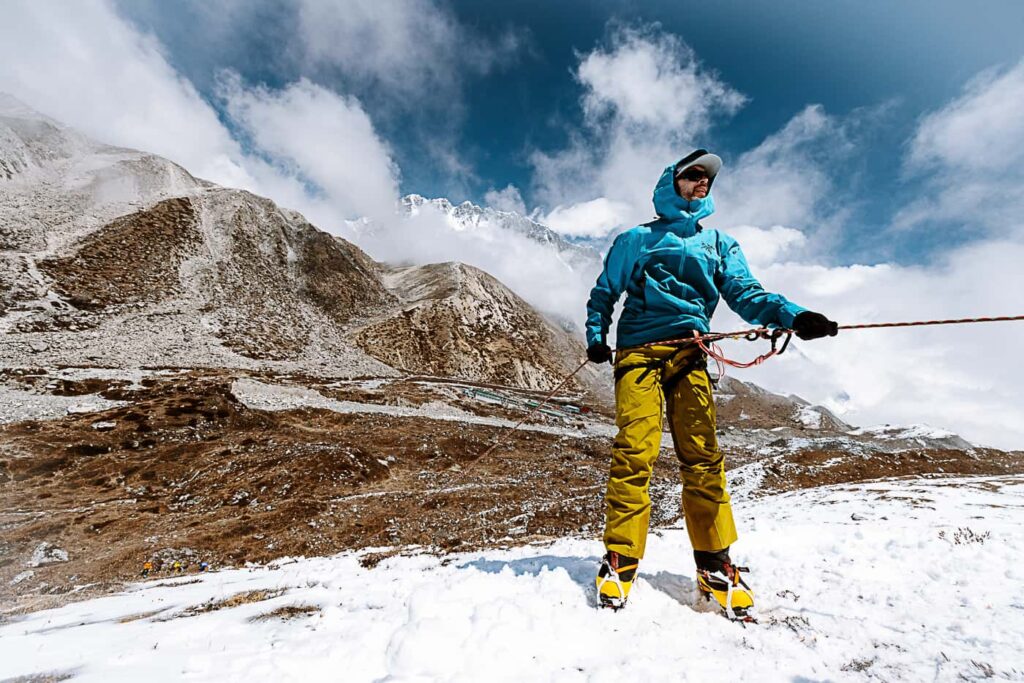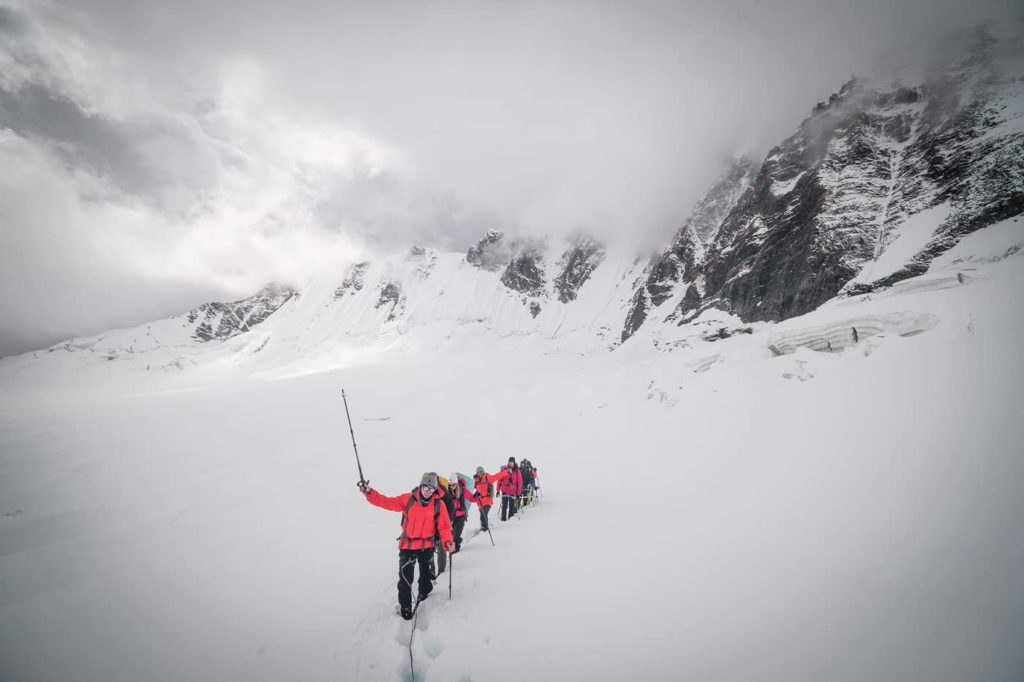Snow can be really perilous: slippery when wet and deceptive when thin, it’s a tricky obstacle on many excursions. Learning when and how to use crampons is vital to any winter athlete’s success. This piece of equipment enables mountaineers to tackle icy, steep, and dangerous terrain by creating traction on their feet.
But determining when you should use crampons can be a challenge, depending on the trip. Microspikes are often enough, but when they’re not, you’ll need something more aggressive.
Whether you’re hiking, climbing, or mountaineering, chances are that a pair of crampons could come in handy in some conditions. Let’s break down when crampons are best and get a little into how to use them..
What is a crampon?
Crampons are traction devices that adventurers fasten to their boots to provide extra grip on icy and snowy terrain. These tools allow you to hike with spikes on the bottom of your feet that penetrate ice and snow in order to keep yourself stable on slippery surfaces. Crampons have evolved over the years to become lightweight and efficient, making them indispensable for most mountaineers.

The Difference Between Crampons and Microspikes
While both crampons and microspikes provide traction on icy and snowy surfaces, there are significant differences between the two devices.
- Design and Use: Crampons are designed for extreme conditions with thick ice and hard-packed snow. Generally, they’re robust and provide added stability. In contrast, microspikes are a less aggressive traction device that easily attach to trail shoes and boots. While crampons can most often be found on ice climbing routes and in mountaineering settings, microspikes more often appeal to the urban hiker or runner.
- Performance: Crampons are designed to handle steep, technical terrain while microspikes accommodate mild ice and snow.
- Application: High-altitude climbers and mountaineers gravitate towards the use of crampons, while everyday adventurers are more inclined to use microspikes.
Understanding the differences between mountaineering crampons and microspikes is a crucial step to preparing yourself for your next adventure.
Types of Crampons
Crampons come in a lot of different shapes and sizes, and some adventures require a specific type of traction. Let’s talk about the various types of crampons and when they’re most appropriate.
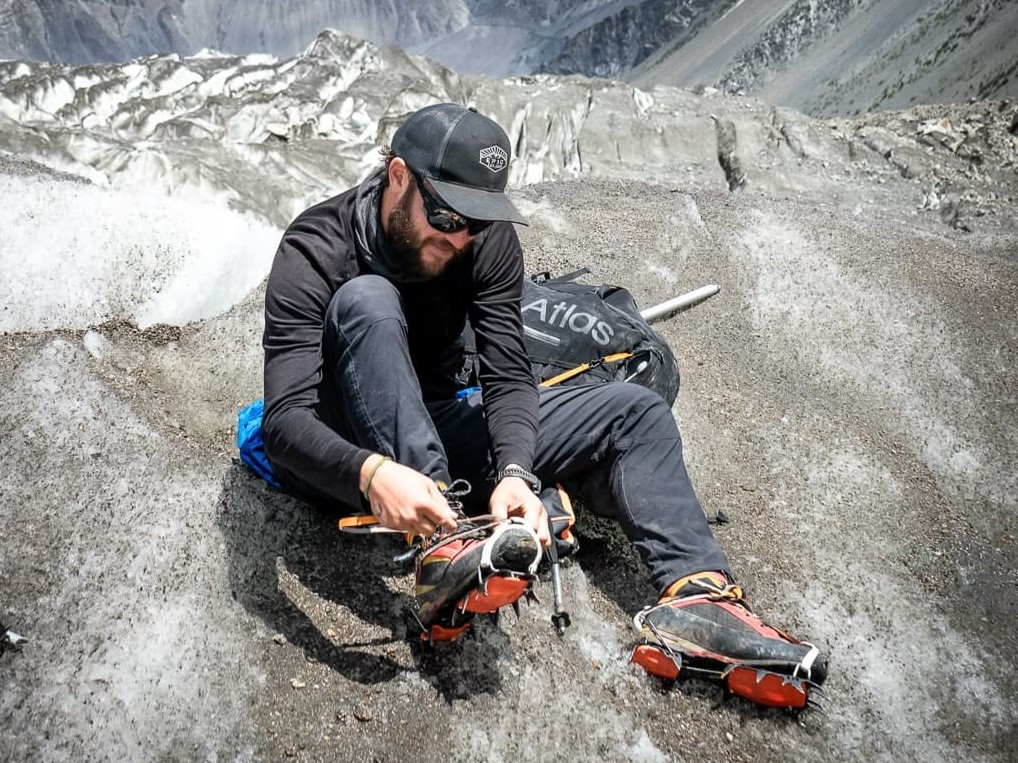
10-Point vs 12-Point Crampons
Crampons typically come with 10 or 12 points (spikes), which helps to determine the amount of traction and control that they’ll provide. 10-point crampons are usually enough for most moderate climbs or hikes featuring snowy/icy conditions. But if the going gets tougher, you might need to get tougher crampons with a few extra spikes.
- 10-Point Crampons: Crampons that come with 10 points are a slightly less aggressive version of a crampon than the 12-point style. This means that they should be used in moderate or slightly less technical territory. This style of crampon is usually more comfortable than the alternative option and can attach to more types of boots, which makes it a good option for comfort-focused trekking.
- 12-Point Crampons: Compared to 10-point crampons, 12-point crampons provide more traction and better penetration into icy surfaces. This makes them the ideal pick for technical ice climbing and steep or hazardous terrain. However, 12-point crampons have a tendency to be less comfortable than 10-point crampons, and they tend to be slightly heavier as well. Overall, 12-point crampons are usually more versatile and ideal in technical situations.
Steel vs Aluminum Crampons
Most crampons are made out of either steel or aluminum. Each material has its advantages and disadvantages.
- Steel Crampons: Steel is known for its strength and durability. This material can withstand a lot of use and obstacles, making it a great option for those who are looking for a workhorse material. While steel usually makes for a heavier crampon, it can be a good choice for long expeditions and technical climbs due to its reliability and consistency.
- Aluminum Crampons: Aluminum is a lightweight material that’s a great companion for climbers and mountaineers who prefer to tackle obstacles by going light and fast. This material is less likely to contribute to excess fatigue. And, while it isn’t quite as durable as steel, its performance caters well to advanced athletes on strike missions.
Both steel and aluminum have their advantages when it comes to supporting hikers, climbers, and mountaineers. Determining which material is best for your circumstances starts with evaluating the expected environments, your budget, and your desires as an athlete.
Attachment Mechanisms
Crampons come with a few different attachment mechanisms. These devices determine how the crampon attaches to your boot, which can impact comfort, stability, and convenience.
- Step-in Crampons: The step-in style of crampon is designed to work with rigid boots. In order to attach them to your shoes, you simply step into the frame of the crampon, which locks into place via a lip on your boot or a “lug”. This is a convenient system, but it isn’t compatible with every style of boot.
- Hybrid/Strap-on Crampons: This style of crampon utilizes a series of straps that allows you to customize the tension around your boots. It’s more adjustable than other crampon styles, which is great for mixed conditions. They can fall off boots though if not properly attached.
- Automatic/Binding Crampons: Some of the newer models of crampons come with an automatic binding system that combines the step-in style with the hybrid style of crampon. This means that you can both strap into the crampons and adjust the straps.
When to Use Crampons
There’s a steep learning curve among new mountaineers and those venturing into alpine environments for the first time. One key factor to setting yourself up for success is choosing the right equipment; another key factor is determining when to use that equipment.
Crampons can be used in both hiking and climbing environments – here’s what you need to know about the appropriate setting for crampon use.
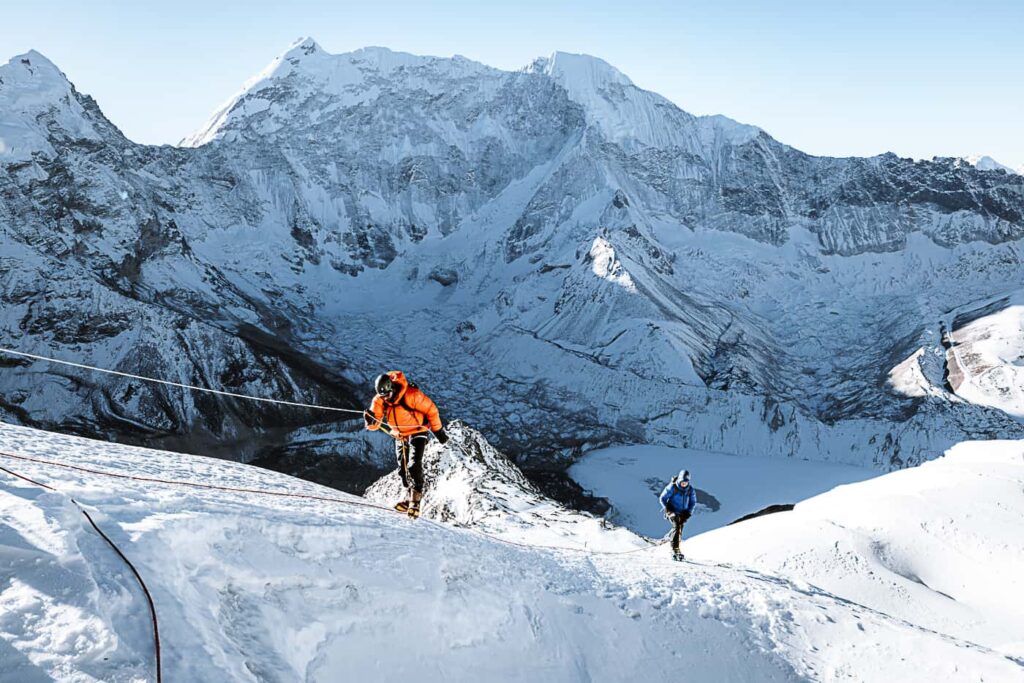
Hiking with Crampons
In most settings, crampons are overkill for hiking. However, some high-altitude treks and winter-oriented expeditions may require the use of crampons. Knowing the difference between hiking and mountaineering boots is the first step you need to take while prepping for crampons. And, while microspikes are often adequate in light ice and snow, crampons become indispensable when:
- Terrain is steep and icy: Crampons are the ideal traction pick when terrain becomes steep and extra icy.
- You’re exposed to a lot of ice and snow: Covering long distances over icy terrain can be really dangerous without proper traction. Crampons can be used to accommodate extended journeys through winter conditions.
- Weather conditions are volatile: Changing weather conditions can make for tricky expeditions. If the temperatures drop or a blizzard strikes, having crampons on hand can significantly enhance safety.
- You’re on technical terrain: Routes that contain short sections of steep terrain or patches of ice may still require the use of extra support. In situations like these, it can be really comforting to have crampons at the ready.
When researching a new multi-day trek or expedition, you may or may not decide to take a pair of crampons with you, depending on the conditions you’re expecting. You may not need them in the end, but if you do and you happen not to have any, it’s most likely the end of the line. So stuff a pair in your bag (preferably in a case to prevent accidental punctures) and whip them out on the trail when you need them.
Climbing with Crampons
Climbing is a sport that requires a lot of finesse and know-how. It also requires a lot of gear. Climbers who expect to spend time on glaciers or steep ice faces often see crampons as a vital
piece of equipment. These devices are essential while:
- Ice Climbing: Navigating frozen waterfalls and steep ice walls can be extremely treacherous without foot traction. Fortunately, crampons allow athletes to anchor into the ice by relying on aggressive 10 or 12-point crampons to secure them to the wall.
- Mixed Terrain Climbing: Many mountaineering settings transition from rock to snow and ice. These constantly changing environments require versatility and specific equipment. In most cases, crampons that offer a secure fit, like a hybrid system, are ideal in mixed environments.
- Navigating Extreme Weather: Extreme weather can limit visibility and make it difficult to predict whether or not a surface will be slippery. Conditions like these warrant the use of crampons for added security.
Planning a climbing trip can be challenging, but equipping your boots with the right traction goes a long way towards adding security to the trip.
Here at Epic Expeditions, there are a few different trips that require the use of crampons – these feature either sections of technical climbing or more demanding terrain. One good example is the K2 Base Camp Trek, which features an ascent of the high alpine pass: Gondogoro La. While not technical in nature, the terrain is snowy, and the incline is enough to warrant extra traction – microspikes just aren’t enough.
How to Use Crampons
Understanding how to use crampons is critical to success in extreme mountain conditions. Here’s what you need to know about using crampons while tackling your next adventure.
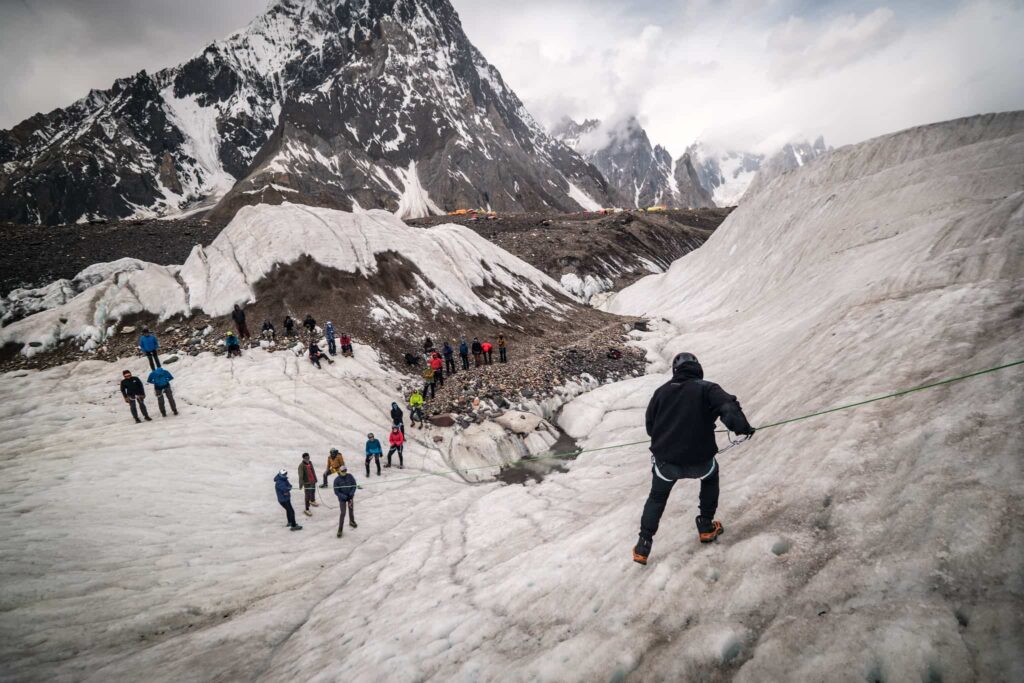
Putting on Crampons
Before tackling an icy or extra-snowy route, it’s really important to learn how to properly fit your crampons around your boots.
- Preparing your system: While getting ready for your trip, inspect your boots to ensure they’re not damaged and can accommodate the crampon’s attachment style. Evaluate the crampons for loose parts or damaged attachments, or straps to ensure they’re ready for your trip.
- Attaching your crampons: The crampon attachment process is relatively simple. Step-in crampons require you to align your foot with the front of the system before sliding your foot into the binding. Those who use hybrid models will step on the crampon before wrapping straps around the collar and heel of the boot. And automatic systems can vary, but they usually involve positioning the foot inside the system before engaging a lever or dial.
- Tightening crampons: Make sure that the straps are laced properly through the front binding, that they are taught when looped back towards the ankle, and that any excess fabric is tucked away safely so as not to get in the way. The loop rings should always face out away from the feet.
Techniques for Walking with Crampons
The first time an athlete wears crampons, they feel bulky and difficult to manage. But with practice, they begin to feel more like a safety net than a hindrance. These strategies can set you up for success:
- Adopt a low, balanced stance: A low center of gravity will help athletes to maintain balance and stay more secure on the mountain. This can be achieved with a slightly bent knee position, which will generally afford more control.
- Take short, controlled steps: Long strides are more likely to result in the loss of control in slippery conditions. As a result, it can be helpful to take short, deliberate steps to maintain a consistent grip on the surface of the mountain. Make sure you are lifting and placing your feet as vertically as possible – avoid dragging or kicking, which can lead to catching pant legs or gaiters.
- Practice traversing: Traversing, or moving laterally, can feel unnatural if you’re new to it. But it’s important to practice this skill set while wearing crampons to give yourself more versatility and skill in slippery situations. The French technique is one of the most effective means of tackling icy inclines and is fairly easy to learn.
- Spend time on mixed terrain: Transitioning from walking on ice, rock, and snow can feel precarious. But with time, athletes are quick to learn how to protect the spikes on the crampons as they navigate rock and how to best orient their feet.
In addition to practicing walking with crampons, make sure to regularly check your crampons for loosening. Adjusting your system as you go can help prevent accidents on your trek. Stopping to reattach your crampons is tedious and may not be an option on some routes. Tie them right the first time and then forget about them.
The Best Crampons for Different Cases
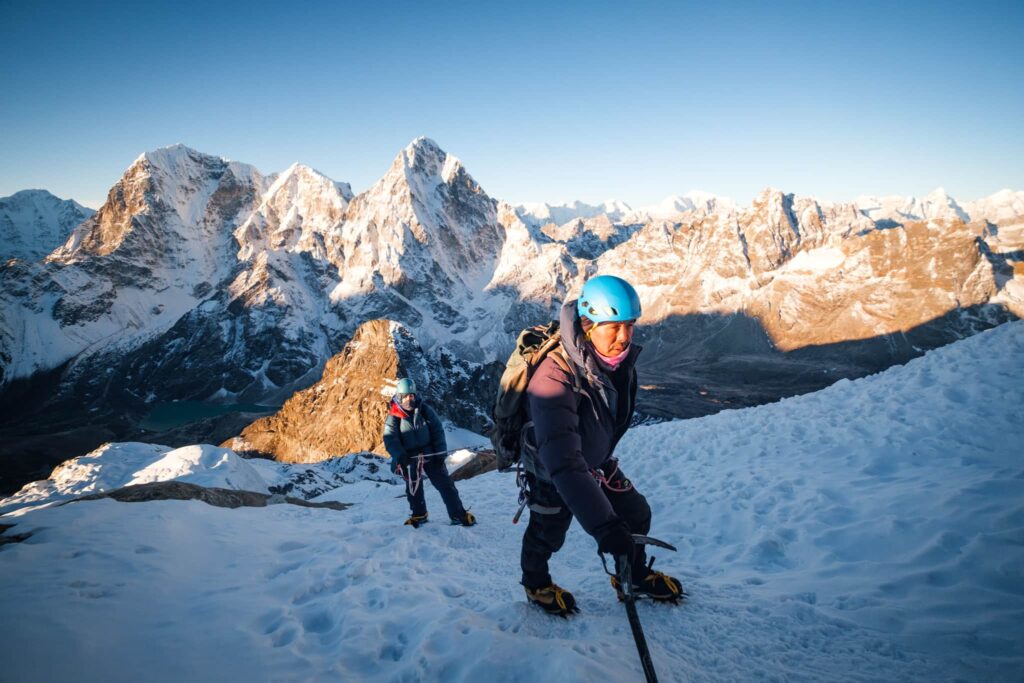
Choosing the right crampons depends on variables like terrain type, your level of technical expertise, and your mountaineering goals. The following recommendations are based on common mountain situations.
- General hiking in the winter: Avid winter hikers and backpackers can often benefit from a 10-point aluminum or steel crampon like the Grivel G10 New-Classic EVO Crampons. A system like this will offer a lightweight design while enhancing stability and support.
- Technical ice climbing: A 12-point steel crampon like the Grivel G12 New-Matic EVO Crampon is usually the best option when an athlete is facing steep, technical terrain since it enhances security and allows you to penetrate ice on challenging ascents.
- Mixed terrain and mountaineering: Mountain athletes who face a blend of rock, snow, and ice are often likely to grab a hybrid or strap on crampons like the Black Diamond Contact Strap Crampon because of its added stability and versatility.
- Budget-friendly options: Let’s face it, mountain gear is expensive. But you don’t necessarily have to buy the most expensive crampons to find a secure system. The C.A.M.P. Stalker Universal Crampons, for example, enhance performance in moderate mountain conditions for a more accessible cost.
- Lightweight crampons for long treks: Athletes who love to travel light and fast are quick to snatch a pair of lightweight crampons like the Black Diamond Neve Pro Crampons. While these crampons are not quite as versatile as some of the options on this list, their 394-gram weight makes them one of the lightest options on the market. This is great for long treks with moderate winter conditions.
Wrapping Up
There are few things more invigorating in life than stepping onto a steep mountain for your first mountaineering trip. But learning how to adequately prepare and condition for your trip is vital to its success. Packing the right crampons is one piece of the equation that adds to a safety-focused trip.
Whether you’re navigating icy slopes, crossing glaciers, or tackling mixed terrain, understanding when and how to use crampons can make all the difference. The right pair not only enhances traction but also helps prevent dangerous slips and falls.
Equally important is knowing how to properly fit and use them with your boots, as well as practicing techniques like flat-footing and front-pointing before you find yourself on exposed terrain. Mastery of these basics ensures you’re not only safer but also more confident in demanding alpine environments.
Ultimately, the careful selection and correct use of crampons can turn a potentially hazardous climb into a confident, rewarding experience. With proper preparation, your journey into the mountains can be both safe and unforgettable.


